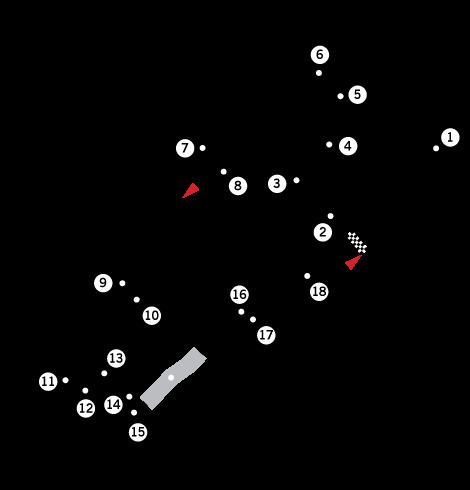Date June 22, 1986 Course length 4.120 km (2.56 mi) | ||
 | ||
Course Temporary street course Distance 63 laps, 259.56 km (161.28 mi) | ||
The 1986 Detroit Grand Prix was a Formula One motor race held on June 22, 1986, in Detroit, Michigan.
Contents
Summary
Lotus-Renault star Ayrton Senna started on the pole and came away with a hard-earned win, the fourth of his career. The young Brazilian charged through the field after dropping to eighth with a deflating tire for his first USGP victory. The race saw six lead changes among five drivers, and the victory for Senna began a streak that would see him take five United States Grand Prix wins in six years.
American Eddie Cheever, in his only F1 race of the season, was taking Patrick Tambay's seat in the Carl Haas Lola, as Tambay had not fully recovered from his Montreal injuries. Haas had attempted to get the legendary Mario Andretti, but, apparently because of a FISA-CART feud, Andretti's application for a FISA license was denied (allegedly Haas then tried for Michael Andretti on Mario's suggestion but his bid was also denied). Cheever, who was racing in the 1986 World Sportscar Championship for the TWR Jaguar team, already had an FIA Super Licence and had no such issues qualified tenth (out-qualifying temporary team mate Alan Jones by almost 3 seconds), and retired at just over half-distance with a broken wheel peg.
As expected, the drivers had difficulty finding grip in Friday's sessions, as the temporary street circuit needed time to get some rubber down. Williams-Honda driver Nigel Mansell was the only one under 1:40, putting in two outstanding laps on race tires. On a gorgeous Saturday, Mansell and Senna bided their time, waiting until halfway through the one-hour session to take the track. Senna came out on qualifiers, managed to get a clear track, and clocked a course record 1:38.301. Mansell was balked on his run on the fragile qualifying tires when Alain Prost crashed in the chicane, and Senna had the pole by more than half a second.
Sunday was hot and humid with a chance of rain. At the start, Senna led Mansell into the first corner, and René Arnoux's Ligier-Renault jumped ahead of Nelson Piquet in the second Williams.
Beginning lap 3, Senna missed a gear entering Turn One, and Mansell's Williams shot by into the lead.
By the end of lap 5, Mansell's lead was 4.3 seconds, but that was as big as it got. His rear brake pads were too cool and had become glazed, and Senna was able to draw back up to him. By lap seven, he was right on his gearbox, and on lap 8, he retook the lead.
Senna immediately began to draw away, while Mansell slipped back through the field. On lap 14, with a 6.5 second lead, Senna suddenly ducked into the pits with a slowly deflating right rear tire. Despite a quick change, he re-entered in eighth place, twenty seconds behind the new leader, René Arnoux.
Arnoux held the lead for just three laps before having to pit for new rubber. His Ligier team mate Jacques Laffite, running with harder compound Pirelli rear tires, moved to the top of the score sheet. At age 42, it was Laffite's first time to lead a race in more than three years, and the last time in his career.
After his stop on lap 14, Senna had begun to carve his way back to the front, overtaking, not back markers, but the best drivers of the era. He passed the struggling Ferraris of Michele Alboreto on lap 15, and Stefan Johansson on lap 17. He then passed Arnoux when he made his tire stop on lap 18, Prost's McLaren-TAG on lap 28, and Mansell on lap 31. When Laffite also stopped for tires on lap 31, Piquet became the race's fifth different leader, and Senna was up to second place, just 1.7 seconds behind.
With the two of them in front on their own, and Piquet leading by up to 3.5 seconds, Senna was content for the time being to follow his countryman. After eight laps in the lead, Piquet pitted for tires, and Senna regained first place.
Piquet's 18.4 second stop was even slower than teammate Mansell's had been, but when he returned to the track, the two-time champion got the bit between his teeth. Running second behind Senna, Piquet set the fastest lap of the race on lap 41, but with a pit stop ten seconds quicker than Piquet's, Senna was able to retain the lead.
On the very next lap, the 42nd, Piquet pushed a bit too much, and crashed hard at the left-hand corner before the last chicane. He ended up in the tire barrier, unhurt, but with his car in a very precarious position. The crane, present for just that reason, was unable to move the car. Arnoux, now 16.6 seconds behind in second, took a second a lap off Senna's lead for five laps while a yellow was displayed in the corner where Piquet had crashed. As soon as the yellow flag was gone, Arnoux went wide and hit Piquet's abandoned Williams! The Frenchman decided that his car was not damaged, and attempted to rejoin the field, but did so right in front of Thierry Boutsen's Arrows-BMW, sidelining both cars.
Very uncharacteristic of a street race, these three – Piquet, Arnoux and Boutsen – were the only drivers all afternoon to retire due to accidents.
With 17 laps to go, Senna led Prost by 27 seconds, but the McLaren's TAG engine was cutting out under braking. Laffite was able to close as Prost struggled, and quickly the Ligier moved by into second place. Senna came home 30 seconds in front for a his first victory in the United States, and the only American win for the Renault.
